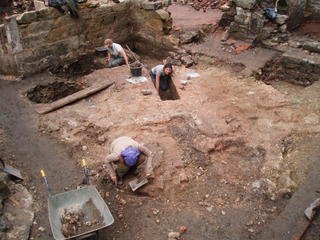First Steel Furnace in England
 The 2005 season was the third involving collaboration between the Ironbridge Gorge Museum and Wilfred Laurier University. With students from the UK, Canada and the US under the expert - if sometimes slightly frazzled - guidance of directors Paul Belford and Ron Ross, we opened an enormous hole and discovered that there were three main phases of site occupation. Phase 1 - The steel furnace. This was built in 1619, subsequently modified and extended and then later (probably c.1630) joined by another furnace of the same sort of size and dimensions. The furnace was circular in form, approximately 6m in diameter, with two separate flues on which a coal fire was lit to heat the cementation chest. The wrought iron in the chest would have been packed with charcoal and the carbon from the charcoal was absorbed into the iron... thus making steel! The furnaces went out of use in the 1680s.
The 2005 season was the third involving collaboration between the Ironbridge Gorge Museum and Wilfred Laurier University. With students from the UK, Canada and the US under the expert - if sometimes slightly frazzled - guidance of directors Paul Belford and Ron Ross, we opened an enormous hole and discovered that there were three main phases of site occupation. Phase 1 - The steel furnace. This was built in 1619, subsequently modified and extended and then later (probably c.1630) joined by another furnace of the same sort of size and dimensions. The furnace was circular in form, approximately 6m in diameter, with two separate flues on which a coal fire was lit to heat the cementation chest. The wrought iron in the chest would have been packed with charcoal and the carbon from the charcoal was absorbed into the iron... thus making steel! The furnaces went out of use in the 1680s.
 Phase 2 - The malthouse. From the late 17th century the site underwent a few changes in ownership and design. By the 1730s the steel furnace had been demolished and the buildings surrounding it adapted for use as a malthouse. Here barley was soaked, sprouted and dried as preparation for use in brewing. We found settling tanks, the base of the kiln, and several varieties of drying floor tiles.
Phase 2 - The malthouse. From the late 17th century the site underwent a few changes in ownership and design. By the 1730s the steel furnace had been demolished and the buildings surrounding it adapted for use as a malthouse. Here barley was soaked, sprouted and dried as preparation for use in brewing. We found settling tanks, the base of the kiln, and several varieties of drying floor tiles.
Phase 3 - Tenement housing. By the later 18th century a rather ramshackle range of tenements had been added to the western side of the malthouse. In the 1840s the malthouse itself was converted into a row of 12 back-to-back houses. These survived in use until the 1960s. We found an old domestic cooking range...

...in one of the kitchens and a number of fireplaces still in situ. We were pleased to have visits from people who had lived (or whose ancestors had lived) in the houses - a nice link with oral history and historical archaeology.
Now the only problem is to get the post excavation work done!

0 Comments:
Post a Comment
<< Home